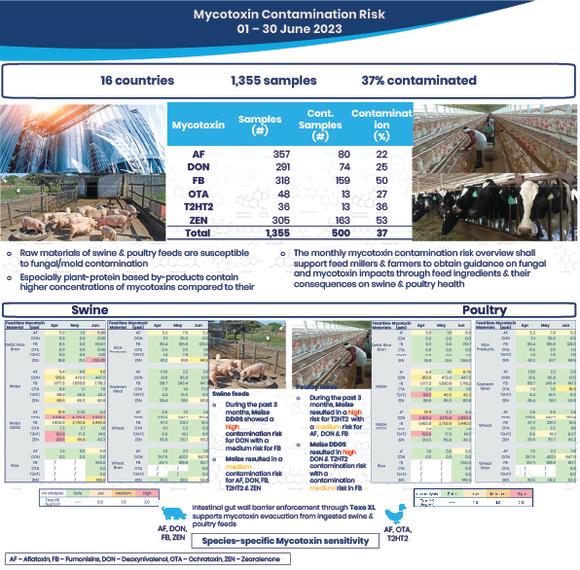Explore all the information on
Mycotoxins
Welcome to the page about Mycotoxins of Engormix; a source of knowledge on Mycotoxins.
Trouw Nutrition has been analyzing mycotoxin risk contamination around the world by our Mycomasters from June 1 – 30, 2023: Mycotoxin Risk Management (MRM) program. ...
Comments : 0
Recommendations: 0
Trouw Nutrition has been analyzing mycotoxin risk contamination around the world by our Mycomasters from June 1 – 30, 2023: Mycotoxin Risk Management (MRM) program. ...
Comments : 0
Recommendations: 0
Wheat—the most widely cultivated crop in the world—is under growing attack from harmful toxins. Across Europe, almost half of wheat crops are impacted by the fungal infection that gives rise to these toxins, according to a study led by fungal biologist Dr. Neil Brown from the U.K.'s University of Bath, in collaboration with colleagues at the University of Exeter.
These troublesome "mycotoxins" are produced by the fungus that causes Fusarium Head Blight, a disease that...
Comments : 0
Recommendations: 0
...
Comments : 0
Recommendations: 0
INTRODUCTION The Food and Agriculture Organization (FAO) estimated that 25% of global food crops are contaminated with mycotoxins 1 . Recently, the prevalence of the mycotoxins detected in food and feed crops was reported to be up to 60–80%2 . Aflatoxins are the major ones among all mycotoxins and produced by Aspergillus spp. upon and after infection of crops. They are genotoxic and carcinogenic to animals and humans 3–6 . From the different...
Comments : 0
Recommendations: 0
Introduction Buffaloes are known to be more efficient in utilizing fiber component of coarse feed than cattle and they thrive well on crop residues, cropping native varieties, and agri-by products (Punia and Singh, 2001). Mycotoxin contaminations are serious issues in farming and animal husbandry. So far, various mycotoxins have been identified and over 25% of the world annual grain production is contaminated with mycotoxin (Smith et al., 2016). The optimum temperature for...
Comments : 0
Recommendations: 0
.jpg&w=3840&q=75)
Dr. Swamy Haladi, Global Programme Manager- Mycotoxin Risk Management at Trouw Nutrition, Shares his insights on why mycotoxins are always a problem in the feed
...
Comments : 1
Recommendations: 5
by Sam Shafer
Poultry researchers show there’s no safe amount of moldy corn
Poultry scientists are taking a close look at moldy corn in an effort to better protect animal and human health. In a recent study, published in Poultry Science ® , researchers measured bird performance and examined mycotoxin levels when laying hens were fed different amounts of moldy corn.
Mycotoxin are toxins made by...
Comments : 0
Recommendations: 1
In 2022 mycotoxins annual survey, Life Rainbow Biotech randomly collected 342 feed samples of raw materials and feed mills in farms and analyzed. The samples were tested for aflatoxins (B1, B2, G1, and G2), zearalenone, fumonisins (B1, B2, and B3) and deoxynivalenol (DON) by the ELISA Mycotoxin analysis kit. Results: From January to December 2022, the import volume of feed corn was 4,383 thousand tons, and Brazil and Argentina is 32.05% and 31.27%, followed by South Africa...
Comments : 0
Recommendations: 1
1. Introduction Mycotoxins are secondary metabolites produced by specific fungi that are natural contaminants of foods [1]. At appropriate ambient temperature and humidity conditions, mycotoxins can be found at any stage of the production chain. However, the fungi presence does not imply mycotoxin formation [2]. Upon ingestion by ruminants, aflatoxin B1 (AFB1) is partially destroyed in the rumen, whereas the absorbed AFB1 rapidly undergoes metabolic processes in the liver...
Comments : 0
Recommendations: 1
Aflatoxins are fungal metabolites—mainly produced by Aspergillus flavus and Aspergillus parasiticus living in soil—that contaminate crops throughout growth, harvest, storage, transportation, and processing. Aflatoxin B1 is not only the most potent natural carcinogen known, but also the most commonly produced toxic strain. As of 2010, roughly 5 billion people worldwide were estimated to be exposed to high levels of aflatoxins. High consumption levels can result in aflatoxicosis,...
Comments : 0
Recommendations: 0
INTRODUCTION Aflatoxins (AFs) in food and feed are recognized as a public health problem of considerable importance. Williams et al. (2004) estimated that 4.5 billion of the world’s population is exposed to AFs. Because security blankets in crops at pre-harvest and post-harvest level are not as strict as in developed countries, populations of developing countries are the most susceptible to aflatoxicosis illness (Williams et al., 2004). The same problem occurs with milk...
Comments : 0
Recommendations: 0
We appreciate the work you do in keeping our food supply safe. In an effort to continue and improve the tools and technologies used in this endeavor, we kindly as you to share your expertise and input on how various food safety tests are performed in your organization. Through the survey below, we’ll explore your thoughts and operations around food safety testing programs from commodities to final product. The survey takes approximately 15 minutes to complete.
We realize food...
Comments : 0
Recommendations: 1
.jpg&w=3840&q=75)
Dr. Swamy Haladi, Global Programme Manager- Mycotoxin Risk Management at Trouw Nutrition, shares his views on what are the most common Mycotoxin he has found in the feed...
Comments : 0
Recommendations: 0
.jpg&w=3840&q=75)
Kai-Jens Kühlmann, Regional Program Manager, Feed Safety, shares his views on the benefits of the Mycotoxin Risk Management Programme that Trouw Nutrition offers in Asia
...
Comments : 0
Recommendations: 1
Are Your Feeds Safe? This growing season has been a challenge across the upper Midwest. Whether your crops have been hit with drought or hail the odds are that we are going to see an increase potential for feed contaminants such nitrates or molds which cause mycotoxins. This article focuses on mycotoxins and how to manage them. Mycotoxins: Common Questions What is the difference between molds and mycotoxins? Molds...
Comments : 0
Recommendations: 2
1. INTRODUCTION The field of nanotechnology is one of the most active research areas in modern materials science. The biosynthesis of nanoparticles and nanomaterials as an emerging highlight has been widely attributed in the convergence of nanotechnology and biomedical sciences which opens the avenues and possibilities for wide variety of biological research and medical uses at cellular and molecular level. In the current scenario, the use of biocompatible nanoparticles in...
Comments : 0
Recommendations: 0
Introduction Changing climatic conditions in Western Canada has led to increased amounts of wheat grain failing milling grade standards and as a result more is available as feed (He et al., 2015). One reason for wheat grain failing grading standards is infection with Fusarium graminearum and/or Claviceps purpurea, which produce deoxynivalenol (DON; Bianchini et al., 2015) and ergot alkaloids (EA; Tittlemier et al., 2015), respectively. Due to the ability of the rumen microbial...
Comments : 0
Recommendations: 0
...
Comments : 1
Recommendations: 1
Introduction Mycotoxins are toxic secondary metabolites produced by fungi. They are unavoidable contaminants in foods and feeds, exerting harmful effects upon animal and human health 39 . The most important mycotoxins in naturally contaminated foods and feeds are aflatoxins (AFs), ochratoxins, zearalenone, T-2 toxin, deoxynivalenol and fumonisins 7,32 . Aflatoxin contaminated feeds are a severe threat to both livestock productivity and human health and cause...
Comments : 0
Recommendations: 1



.jpg&w=3840&q=75)

.jpg&w=3840&q=75)












